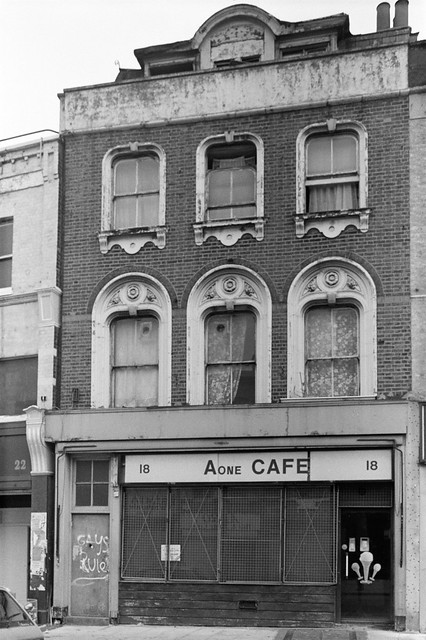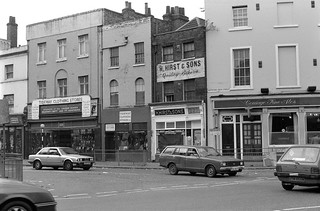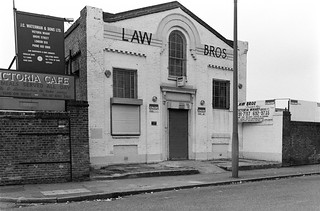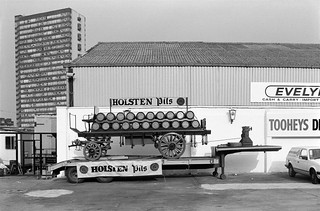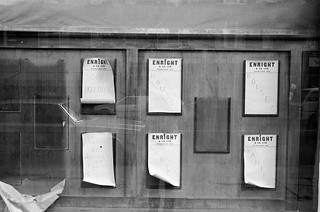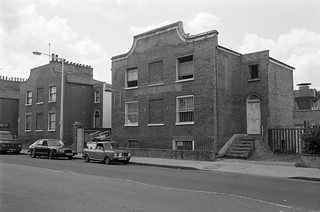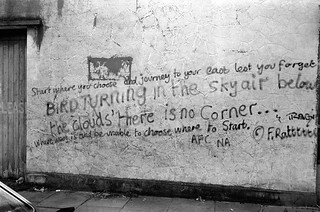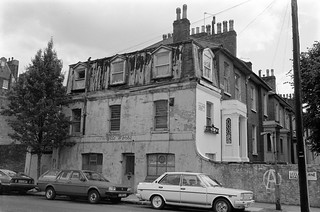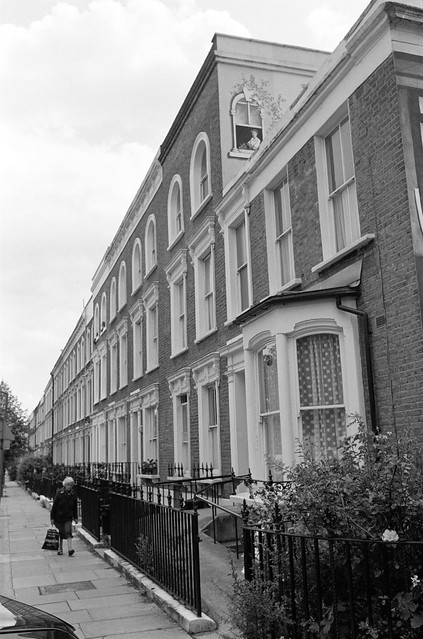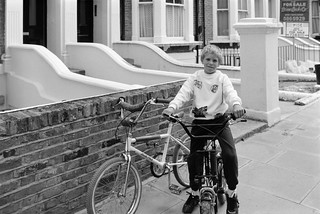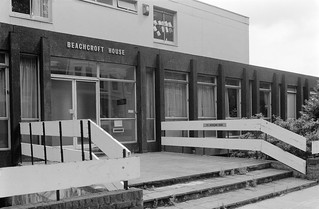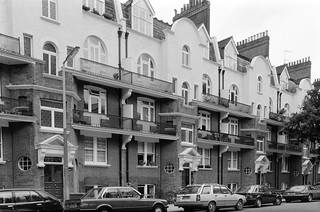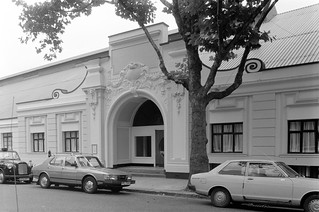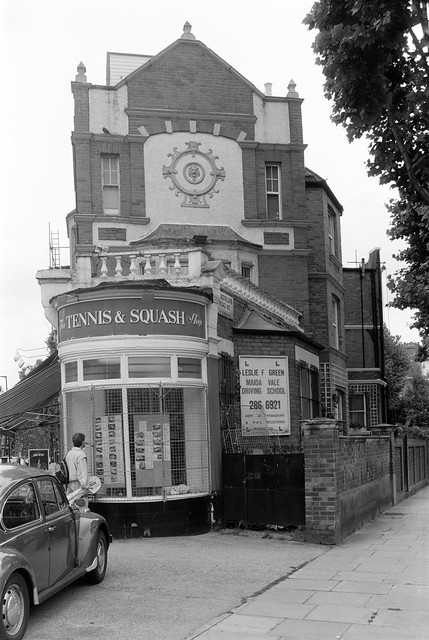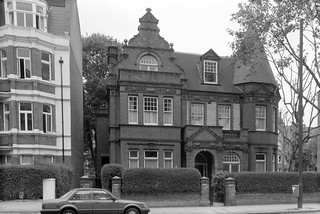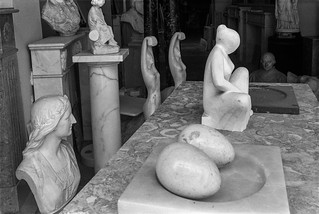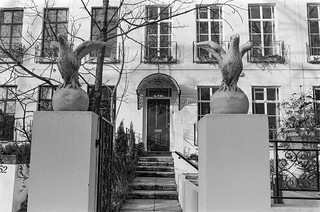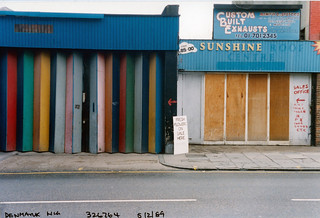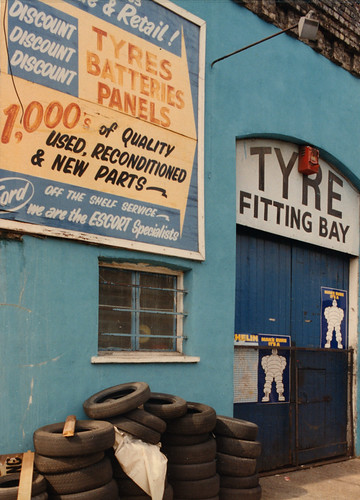More from Deptford 1988 continues my walk around New Cross and Deptford. The previous post was Deptford Broadway And New Cross Road.
13 Deptford High Street is distinguished by the impressive pillars of its entrance and a fine rounded frontage. Whoever it was built for was obviously wealthy and perhaps a shipowner or merchant for goods landed locally either on Deptford Creek or on the Thames, perhaps tea from China. Tea was taxed heavily – 119% – until 1784 and this led to considerable smuggling but parliament reduced to tax then to 12.5% making tea available to a wider range of the population and ending the illegality. Though the East India Company retained its monopoly until 1834.
The house, built on what was then Butt Lane is locally listed is thought to have been built in the early 18th century but its rounded front was probably added around a hundred or so years later.
The ‘A One CAFE’ at 18 Deptford High St looked as if it was no longer in business, though its door still is decorated with ice-cream cones. The doorway leading to the upper residential floors has the message ‘Gays Rule’ and is I think boarded up. This building is still there, its ground floor now a Vets, its brickwork plastered over and generally looking in rather better repair.
Unfortunately this picture is slightly out of focus (though the grain is sharp) and I cannot make out some of the finer detail of the building.
I took only a couple of pictures as I walked up Deptford High Street to its north end and its junction with Evelyn Road/Creek Road, which still looks much the same as in my picture except that all the shops have changed hands at least once.
No 227 was in very poor condition and there was considerable building work there a few years ago but the general appearance is much the same, though it has long lost the shopfront and signage. This Grade II listed house, shop and bakehouse was built in 1791 for Thomas Palmer and improved in the early 19th century, although the ‘RCHME DEPTFORD HOUSES: 1650 to 1800’ survey in 1997-8 suggested it was “perhaps a single late-17th-century house with the front house added c. 1700, extensively rebuilt 1791-2” and says it “has its origins in the period 1654-1692 during which John Evelyn developed a corner of his Sayes Court estate corresponding to Nos 217-227 with a block of nine buildings set back from the road.” It does go on to say the house “was all but wholly rebuilt for Palmer in 1791-2” and remained a bakers until the 1990s.
The Tideway Clothing Stores is now an off-licence and supermart. The Courage Pub at right was torn down illegally without permission in 2019; it had been there at least since the 1820’s and though it looks as if it was still open, closed as a pub around the time I made this picture. The building became offices for a firm of solicitors, and the ground floor was used for art classes. The Deptford Dame published a report of the proposals for its reconstruction in 2021.
Watergate Street is essentially the continuation of Deptford High Street to the north, leading to the River Thames. At the extreme left of this picture you can see a pillar of another Deptford pub, the Harp of Erin at 2 – 4 New King Street on the corner between this and Watergate Street. The pub which went under a variety of names over the years as Round the Bend, Nobody’s Inn, Looney Tunes, closed as simply The Harp in 2014.
Panda Car Hire and taxi service to Airports, Theatres, Stations was next to the pub on Watergate St and had this rather odd imitation half-timbering which attracted my attention. Panda Cars seemed a strange business name, usually used to refer to small police cars driven by police officers which were often painted black and white. The building is still there, and in the same business as Water Gate Cars but has now a rather plainer frontage.
I walked west along Evelyn Street. Parker’s Corner was around half a mile away, just before what is clearly a bridge although the Surrey Canal which used to go under it has long been filled in. I’d photographed this corner three years previously and wrote this about it: “Parkers Corner was next to the former Surrey Canal Blackhorse bridge in Evelyn Street on the corner of Dragoon Road.
Parker’s Timber were based at a wharf on the canal on the northeast of the bridge. The company moved to Belvedere, Kent in the 1960s. Although I was a great fan of Bird, someone else had beaten me to paint Charlie on the wall. ” In this frmae you can still see ‘Charlie’ though a little faded. The sign at top left is for Victoria Wharf, the site behind the wall, and lists some of the businesses there. The modern building behind, Parker House at 144 Evelyn Road, was demolished in 2015
The Victoria Wharf site stretched along Dragoon St from Evelyn Street to Grove Street where Law Bros had this building. Rather oddly a sign at right told me the Bros were Stewart & Alice and their business appear to be in Calor Gas according the the five signs in the picture. At left were signs for two other businesses on the wharf and above the doorway was another for Andrews.
I wondered what this building had been built as; it was marked as ‘Chapel’ on old large-scale OS maps on Grove St beside the wharf entrance. A very bad photograph in the Deptford Archives enabled me to identify it as Victoria Hall Methodist Church, opened in 1857 and demolished in 2015 as a part of the Timberyard development.
Oxestalls Road was created around 1966 when there was considerable redevelopment in the area with the creation of the Pepys estate, and it goes across the former route of the Surrey Canal at an elevated level. This view is looking roughly east and you can see the chimneys and roof of The Victoria pub on Grove Street above the sheds to the left of the picture along with a chimney which I think is at Deptford Power Station.
Tooheys Liquor Barn on Evelyn Street with the trailer of a lorry carrying a Holsten Pils waggon, probably designed to be horse-drawn. It appears to be part of the Evelyn Cash & Carry shed. In the background is Eddystone Tower on Oxestalls Road, 26 floors and 257ft high, part of the GLC Pepys Estate built in 1962.
My walk around Deptford will continue in a later post.

